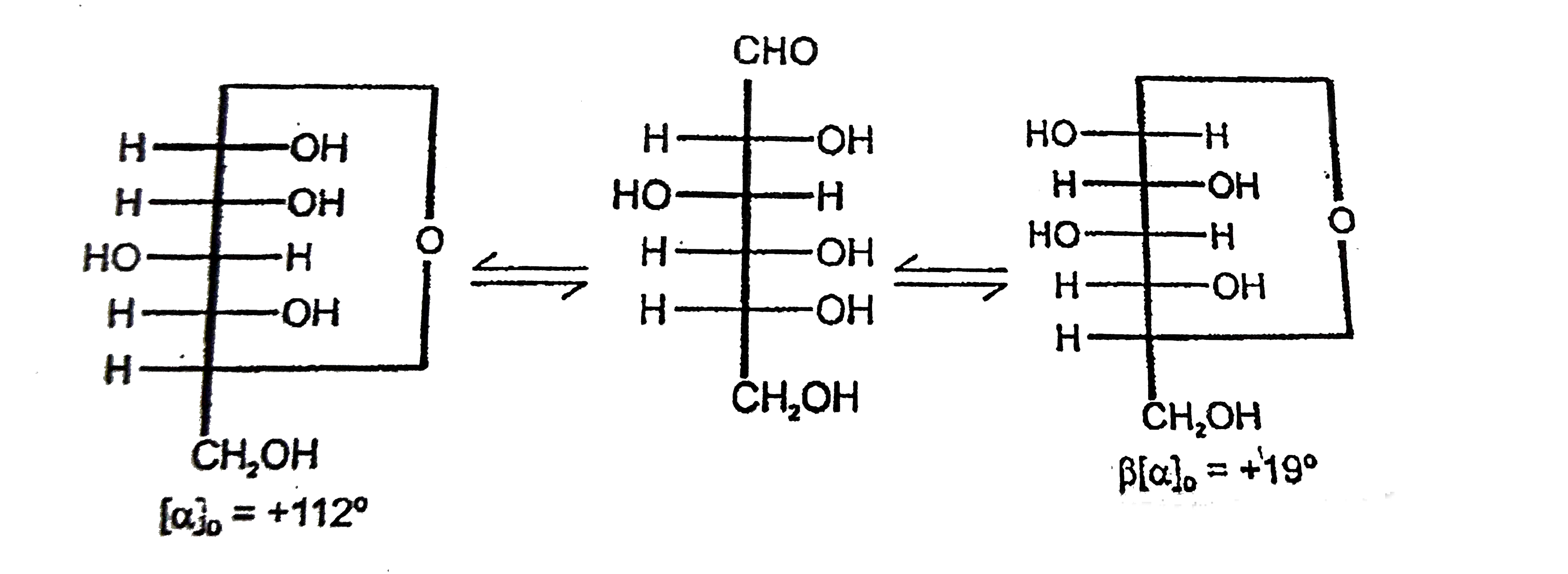The change in optical rotation with time of freshly prepared solution of sugar is known as :
specific rotation
inversion
rotation
mutarotation
The correct Answer is:D
To solve the question regarding the change in optical rotation with time of a freshly prepared solution of sugar, we will follow these steps:
1. Identify the Sugar: The question refers to a freshly prepared solution of sugar, which we will consider as sucrose (C12H22O11).
2. Understand Hydrolysis: When sucrose is hydrolyzed, it breaks down into its constituent monosaccharides, which are alpha glucose (C6H12O6) and alpha fructose (C6H12O6).
3. Optical Rotation Values:
- The optical rotation of sucrose is +66.5°.
- The optical rotation of alpha glucose is +52°.
- The optical rotation of alpha fructose is -92.4°.
4. Calculate the Change in Optical Rotation:
- After hydrolysis, the optical rotation of the resulting mixture (alpha glucose and alpha fructose) will be the sum of their individual optical rotations.
- Therefore, the total optical rotation after hydrolysis can be calculated as:
Optical Rotation=Optical Rotation of Glucose+Optical Rotation of Fructose
=+52°+(−92.4°)=−40.4°
5. Determine the Nature of the Change:
- The initial optical rotation of sucrose was +66.5°, and after hydrolysis, it changed to -40.4°.
- This indicates a significant change in the optical rotation, which suggests that the sugar has undergone a process known as "inversion".
6. Conclusion: The change in optical rotation with time of a freshly prepared solution of sugar (sucrose) is known as inversion.
Final Answer:
The change in optical rotation with time of freshly prepared solution of sugar is known as inversion.
---
- The optical rotation of sucrose is +66.5°.
- The optical rotation of alpha glucose is +52°.
- The optical rotation of alpha fructose is -92.4°.
- After hydrolysis, the optical rotation of the resulting mixture (alpha glucose and alpha fructose) will be the sum of their individual optical rotations.
- Therefore, the total optical rotation after hydrolysis can be calculated as:
Optical Rotation=Optical Rotation of Glucose+Optical Rotation of Fructose
=+52°+(−92.4°)=−40.4°
- The initial optical rotation of sucrose was +66.5°, and after hydrolysis, it changed to -40.4°.
- This indicates a significant change in the optical rotation, which suggests that the sugar has undergone a process known as "inversion".
The change in optical rotation with time of freshly prepared solution of sugar is known as inversion.
Similar Questions
Knowledge Check
Synthetic polymer prepared by using caprolactam is known as
AteryleneBteflonCnylon 6DNeopreneSynthetic polymer prepared from caprolactum is known as
Anylon-610BteflonCteryleneDNylon-6D (+) Glucose has melting point 146∘C and specific rotation [α]25D is + 112∘C. Another D(+) Glucose has melting point 150∘C and specific rotational [α]25Dis +18.7∘C. The two form have significantly different optical rotation but when an aqueous solution of either form is allowed to stand, it rotation changes. The specific rotation of one form decreases and rotation of other increases until both solution show the same value +52.7∘. The change in rotation towards an equilibrium value is called mutarotation.

What percentage of β-D-(+) glucopyranose found at equilibrium in the aqueous solution?A50%B≈100%C38%D64%
Milk sugar is commoly known as
View SolutionThe freshly prepared solution if sugar undergo change in optical rotation , with time , is known as
View Solution
The above process in which α and β form remain in equilibrium with acyclic form and a change in optical rotation is observed which is known as−
View SolutionAn organic compound is fused with sodium metal and crushed in water. The solution thus obtained when treated with freshly prepared ferric chloride solution gives blood red color solution. The test confirms
View SolutionD (+) Glucose has melting point 146∘C and specific rotation [α]25D is + 112∘C. Another D(+) Glucose has melting point 150∘C and specific rotational [α]25Dis +18.7∘C. The two form have significantly different optical rotation but when an aqueous solution of either form is allowed to stand, it rotation changes. The specific rotation of one form decreases and rotation of other increases until both solution show the same value +52.7∘. The change in rotation towards an equilibrium value is called mutarotation.

Mutarotation is characteristic feature of:
View Solution
